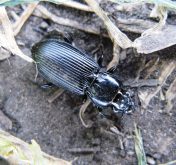Manitoba’s fruit growers are keeping a close eye for signs of spotted wing drosophila, aiming to avoid the toll the tiny fly took on fruit crops last year.
Some growers have already detected it and have applied an approved insecticide to combat against another infestation, provincial fruit crops specialist Anthony Mintenko said July 14.
The fruit crops industry development branch began monitoring for it more than a month ago.
“It’s around. The numbers are still low… but they’re here,” he said.
“Everyone definitely needs to be vigilant about it. We’re in the middle of July. That’s when we saw spikes last year.”

Moisture and temperature conditions for the fly to flourish are also similar to 2015, although there have been more cool days than last year, he added.
“We’re recommending growers start to spray their commercial (raspberry) fields for spotted wing,” Mintenko said.
The invasive fruit fly of East Asian origin was first detected in the Pacific region of the U.S. in 2008 and is now well established across North America. It causes heavy damage to mature fruit crops by piercing healthy fruit and laying its eggs inside.
The Manitoba Agriculture’s Current Crop Topics site indicates berries are susceptible to SWD infestation from when colour starts to appear on the berry right through to the time of harvest.
Read Also

Manitoba sclerotinia picture mixed for 2025
Variations in weather and crop development in this year’s Manitoba canola fields make blanket sclerotinia outlooks hard to pin down
Mintenko said 2016 shouldn’t see the damage that the fly caused last year because many more growers know what to watch for and are taking steps to detect it and protect their fruit crops.
“If they can get one or two sprays on hopefully it can protect that harvest and they can get most of it off this year, as opposed to last year when people didn’t know what it was and lost their whole crop,” he said.
2016 should result in a year of average or better-than-average yields, he said.
That’s despite additional disease pressures from persistent rainfall, especially on strawberries, which can develop botrytis in damp weather.
“There was definitely more fruit rot because of the rain,” Mintenko said.
“The raspberries are starting up now and I’m not seeing it yet, but you can get botrytis in raspberries as well. It’s still too early to say if that’s going to affect the raspberries.
An early-spring frost also did damage to certain varieties of saskatoons, but the rain hasn’t affected them as much and some growers are reporting excellent crops.
Altona-area fruit grower and executive director of the Prairie Fruit Growers Association Waldo Thiessen said from what he’s heard from other growers so far 2016 sounds as if it’s turning out to be a good year, despite the rain.
“It still has been a good crop. I would say across the province it’s been above average.”
Many had an exceptionally early start with strawberries ripening very early, and U-picks opening in June.
“We’re working with an early year,” he said. “We started picking on June 20 and I don’t know that we’ve ever done that before. We were probably a week to 10 days earlier.”
More information on controls for SWD and managing fruit crops is found on Manitoba Agriculture’s website Current Crop Topics link at: http://www.gov.mb.ca/agriculture/crops/seasonal-reports/current-crop-topics.html#horticulture.




















